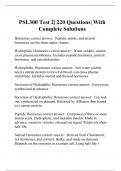Exam (elaborations)
PSL300 Test 2| 220 Questions| With Complete Solutions
Hormones correct answer: Peptide, amide, and steroid hormones are the three major classes. Hydrophilic Hormones correct answer: Water soluble, cannot cross plasma membranes. Includes peptide hormones, protein hormones, and catecholamines Hydrophobic Hormones correct answer: Not water solub...
[Show more]



